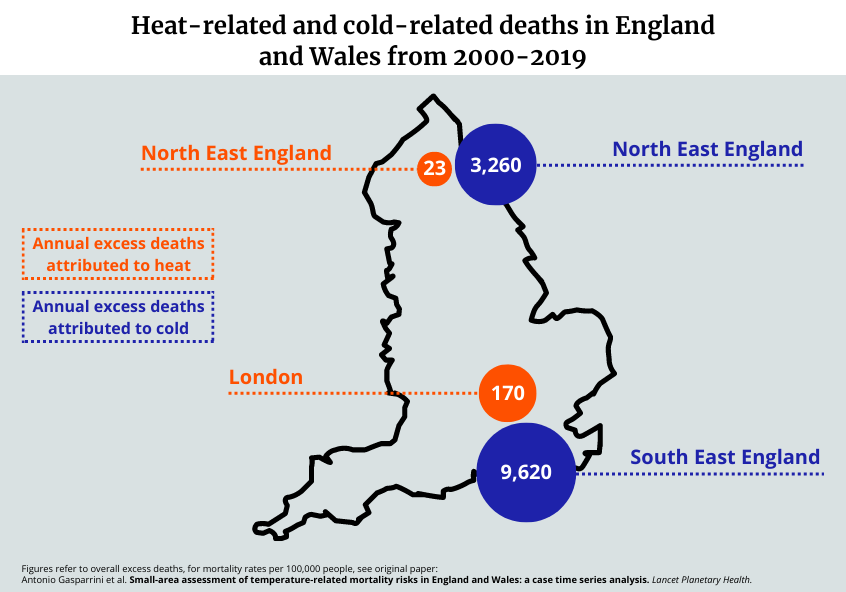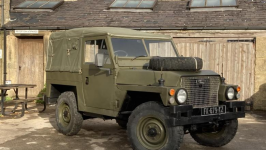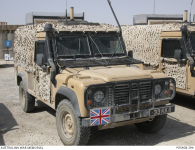OldSolduer
Army.ca Relic
- Reaction score
- 17,718
- Points
- 1,260
Hypothermia is shitty and I suspect many of you know that already. Its ok to be wet, and ok to be cold.Per capita that's pretty shit.
Cold and wet is a recipe for disaster.

Hypothermia is shitty and I suspect many of you know that already. Its ok to be wet, and ok to be cold.Per capita that's pretty shit.
Coming back to this one just because - dog with a bone.
I can confirm that. After around 30 years in Manitoba and 15 years in SW Ontario I can attest that there is definitely a difference between "wet" and "dry" cold. Same-same for the difference between winter exercises in Shilo versus Petawawa.The old Prairie line "It's a dry cold!" has a deal of truth in it.
If I understand the UK statistics properly, the problem is almost entirely related to very old people who actually die within their unheated homes. We don't seem to have the same problem with centuries old buildings with no insulation, a high energy cost and a large elderly, infirm population living by themselves in these conditions.Latvia and the Baltics are as damp and dreich as Britain but also colder.
More Brits die of hypothermia than Canadians (even adjusted per capita) because damp woolies leach the heat out of you faster than dry thinsulate.
I found mine to be pretty good many decades ago. It's gotten a lot better since then.If ISV and Latvia then SOCEM better be real good.
Well, in part, but also tactical mobility once there. There's always been a difference between how we gunners did thing - essentially except for those heliborne winter exercises, we're tied pretty closely to our vehicles regardless of the season - and the infantry - who basically once they get to their destination, leave their vehicles away in a Zulu harbour and their troops spread out tactically. I'm not sure how true that holds for the LAVs, but with the 3/4 and 5/4s and even with the M113s, they were rarely to be seen except when on the move. Companies were more likely to have warming tents (or I guess in Ukraine warming bunkers) rather than vehicles with the heaters running.Correct me if I'm wrong but the purpose of the ISV is simply to get troops from barracks to the front with their kit, rapidly and in good shape.
Therein lies part of the problem. The kit.
I'm not trying to defend the IFV as against any other type of vehicle, I'm just saying that it shouldn't be criticized on the basis that it doesn't offer some specific creature comforts. It's clearly a vehicle that offers motorized transport on most terrain in Latvia and an ability to carry that massive amount of kit that seems to have become the burden of the infantry, and does very little beyond that. To me that's already a lot. Now if its durability and ease of maintenance is confirmed then the grunts have got themselves a winner.

Can you provide a link to your statistics? I'm not disputing your figures (yet?), but making a connection between the potential for cold (and heat) casualties based on "damp woolies" and using it as argument for enclosed and heated tactical vehicles in a temperate climate can lead to m/s injuries due to stretching. If you dived deeper (I haven't yet), you might find that many of those excess winter deaths (EWD) were secondary to hypothermia and mainly in the elderly and frail. You may also find that the "exposure to the cold" that leads to some of those deaths was in their homes not outside.

Both heat and cold increase risk of death in England and Wales but rates vary
Each year in England and Wales, there were on average nearly 800 excess deaths associated with heat and over 60,500 associated with cold between 2000 and 2019, according to a new study published inwww.lshtm.ac.uk

I can confirm that. After around 30 years in Manitoba and 15 years in SW Ontario I can attest that there is definitely a difference between "wet" and "dry" cold. Same-same for the difference between winter exercises in Shilo versus Petawawa.
If I understand the UK statistics properly, the problem is almost entirely related to very old people who actually die within their unheated homes. We don't seem to have the same problem with centuries old buildings with no insulation, a high energy cost and a large elderly, infirm population living by themselves in these conditions.
I found mine to be pretty good many decades ago. It's gotten a lot better since then.
Well, in part, but also tactical mobility once there. There's always been a difference between how we gunners did thing - essentially except for those heliborne winter exercises, we're tied pretty closely to our vehicles regardless of the season - and the infantry - who basically once they get to their destination, leave their vehicles away in a Zulu harbour and their troops spread out tactically. I'm not sure how true that holds for the LAVs, but with the 3/4 and 5/4s and even with the M113s, they were rarely to be seen except when on the move. Companies were more likely to have warming tents (or I guess in Ukraine warming bunkers) rather than vehicles with the heaters running.
I'm not trying to defend the IFV as against any other type of vehicle, I'm just saying that it shouldn't be criticized on the basis that it doesn't offer some specific creature comforts. It's clearly a vehicle that offers motorized transport on most terrain in Latvia and an ability to carry that massive amount of kit that seems to have become the burden of the infantry, and does very little beyond that. To me that's already a lot. Now if its durability and ease of maintenance is confirmed then the grunts have got themselves a winner.






I've always like this Aussie one.Land Rover covered a multitude of sins - recce, CP, staff, gun tractor, "snatch".

Because they aren’t designed for significant off road usage. The curb weight on a Suburban is huge - and realistically it’s a 6 pax vehicle with kit (and it gets cramped with full kit).View attachment 86878View attachment 86879View attachment 86880
For the price you are paying for the ISVs why not just by these - and stay warm and dry?
The link

[Hypothermia] - PubMed
Hypothermia is defined as a core body temperature less than 35 degrees C (95 degrees F) and results from prolonged exposure to cold environment, drugs, and underlying pathologic conditions. Hypothermia is associated with marked depression of cerebral blood flow and oxygen requirement, reduced...pubmed.ncbi.nlm.nih.gov
There are about 20,000 hypothermia--related deaths a year in Britain, about 25,000--in the USA, 8,000 deaths a year in Canada
20,000 / 67,000,000 Brits - 30/100,000
8,000 / 40,000,000 Canadians - 20/100,000
Rising damp and wet wellies.
Hypothermia-Related Deaths --- United States, 2003
Hypothermia, a preventable lowering of the core body temperature to <95° F (<35° C) (1), causes approximately 600 deaths each year in the United States . . .

During 2018–2020, death rates attributed to excessive cold or hypothermia were generally higher in more rural areas. Among females, the death rate increased from 0.11 per 100,000 for those residing in large central metro areas, to 0.40 for those in noncore (rural) areas. Among males, the death rates were lowest for those residing in large central metro areas (0.29) and large fringe metro areas (0.24), and highest in noncore (rural) areas (0.93). Males had higher death rates than females for each corresponding urbanization level.
Epidemiology
About 700 to 1500 hypothermia-related fatalities are reported in the United States each year. The condition most frequently affects adults between the ages of 30 and 49, with occurrence 10 times greater in men than women. However, hypothermia's true incidence is unknown. Even with optimized in-hospital care, the mortality of moderate to severe hypothermia still approaches 50%.
Thanks for replying with that. Unfortunately, I couldn't find a full text version of Dr. Reingardiene's 2003 article (in a Lithuanian medical journal) to view her references as to the source of those numbers. Though I'm sure that there were valid reasons for her to come up with those numbers, they do not seem to be consistent with crude rates of accidental hypothermia as reported by the CDC in contemporary MMWR.
Even if we fast forward a couple of decades, the rate still doesn't approach her totals.

QuickStats: Death Rates Attributed to Excessive Cold or ...
This report describes death rates attributed to excessive cold or hypothermia.www.cdc.gov
Hypothermia - StatPearls - NCBI Bookshelf
Hypothermia is defined as a drop in body temperature below 35 °C. The condition is common in cold geographic areas and during cooler months, though it can also develop in locations with milder climates.[1] Hypothermia affects all organ systems. Presenting symptoms depend on the severity of the...www.ncbi.nlm.nih.gov
Apologies for picking flyshit out of pepper in a thread about a tactical vehicle.
Because they aren’t designed for significant off road usage. The curb weight on a Suburban is huge - and realistically it’s a 6 pax vehicle with kit (and it gets cramped with full kit).
I have a Z71 Burb, with the 6.2 V-8, it’s a great vehicle for moving stuff on roads, but I can tell you trying to follow an ISV or the JLTV on range roads, or off road and it doesn’t do nearly as well.
The Suburban isn’t the same frame as the Colorado or 1500 series trucks either.
The JLTV is massive but it’s got ground clearance up the ass, and armor - its a good vehicle for a light fire support vehicle- but it’s a 4 person vehicle, not 6 or 10 (okay you can stick a few folks on the exposed areas if needed - but it kind of defeats the purpose at the point.
The ISV can do what it can since it’s stripped down to next to nothing - which means you have the ability to sling it from a Blackhawk - for a CA aspect that isn’t exactly helpful though as the Griffon would shit its transmission out the roof if it tried to do that.
I've always like this Aussie one.


Because they aren’t designed for significant off road usage. The curb weight on a Suburban is huge - and realistically it’s a 6 pax vehicle with kit (and it gets cramped with full kit).
I have a Z71 Burb, with the 6.2 V-8, it’s a great vehicle for moving stuff on roads, but I can tell you trying to follow an ISV or the JLTV on range roads, or off road and it doesn’t do nearly as well.
The Suburban isn’t the same frame as the Colorado or 1500 series trucks either.
The JLTV is massive but it’s got ground clearance up the ass, and armor - its a good vehicle for a light fire support vehicle- but it’s a 4 person vehicle, not 6 or 10 (okay you can stick a few folks on the exposed areas if needed - but it kind of defeats the purpose at the point.
The ISV can do what it can since it’s stripped down to next to nothing - which means you have the ability to sling it from a Blackhawk - for a CA aspect that isn’t exactly helpful though as the Griffon would shit its transmission out the roof if it tried to do that.
It's an internal load as well for a CH-47.The ISV can do what it can since it’s stripped down to next to nothing - which means you have the ability to sling it from a Blackhawk - for a CA aspect that isn’t exactly helpful though as the Griffon would shit its transmission out the roof if it tried to do that.
So is a SuburbanIt's an internal load as well for a CH-47.

Neat! Comes with a washing machine!I've always like this Aussie one.





 www.linkedin.com
www.linkedin.com
So is a Mini CooperSo is a Suburban
